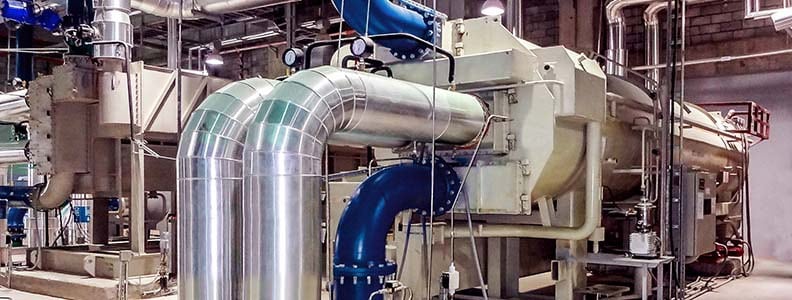There is no argument about the advantages of chilled water systems in large commercial facilities. A chilled water refrigeration system offers many advantages, mainly in terms of energy efficiency and ease of maintenance. You can magnify these advantages for your facility by ensuring proper and consistent maintenance of the system over its lifetime. Remember that the system is more than the chiller itself. Here are some of its components:
- Chillers
- Heat rejection devices
- Chilled water pumps
- Instrumentation
- Electrical & Control equipment
The water chiller is the main component of the cooling plant. However, beyond the chillers other parts and equipment have a key role in the correct performance of the system. It is important not to dismiss any component of the system. Here is a brief discussion of some of them.
Proper Pump Setting and Maintenance
The pumping systems deliver both the warm water to the chiller and cooling water to the heat rejection devices, so it is very critical for the system. Therefore, you may want to minimize the amount of energy used by the pumps as much as possible. First, try these methods:
- Ensure that pressure settings are at their lowest possible and according to the pressure drop of the circuit
- Ensure that scheduling is okay i.e. the chiller and pumps should run concurrently
Common pump maintenance procedures are also important. For example, oil the bearings, alignment the shaft and perform positive suction pressure.
Thermal Energy Storage for Off-Peak Hours
If your installation has energy demand peaks, a Thermal Energy Storage Solution can be an interesting solution. Energy costs change during the day, and if your demand is high at certain hours, normally during the day, you may be losing money. Thermal Storage Tanks store energy during low-demand periods, when it is normally cheaper and more efficient, so you can use it when you really need it. Therefore, it may be interesting for a company to invest in a Thermal Energy Storage solution rather than a new chiller for your chilled water refrigeration system. If you are interested in this solution, contact ARANER for further information.
Invest In a Reliable Water Treatment Method
Though not necessarily exposed to the atmosphere, the water system loop of a chilled water refrigeration system requires regular treatment. Ozone, magnetic and chemical approaches can be used depending on type of system and desired results. What happens if you ignore this maintenance procedure? The pipes may scale and water may turn foul with time, leading to heat transfer problems at the cooling coils and chiller. If by any chance the tubes in the chiller are damaged, system performance is affected immensely. Some of the water at the cooling tower may drift to the atmosphere and give chance to the growth of biological matter at the tower’s basin. Antimicrobial products come in handy in the treatment of this problem.

Double effect VAM
Flow Rates: Neither Too Low nor Too High
The flow rates for both the evaporator and condenser are directly proportional to chiller efficiency. As long as the rates are at least 90 % of the design parameter, the efficiency remains intact. Restriction or reduction of the flow rate will result into laminar flow within the chiller. Greater flow rate is also undesirable; it can cause erosion and wear in the chiller. As the rule of the thumb, make sure the flow rate is within the 2.5 – 3 m/s.
Low Delta T Syndrome
The maintenance of the system and the control of flow rates mentioned above can help you to avoid Low Delta T Syndrome. If this concept is familiar to you, you will already understand how little it is doing to help you solve your energy usage problems. Low Delta T Syndrome is a system problem equivalent to energy waste. When your system is extracting enough heat from the air and transferring it to the chilled water coils, it shouldn’t be a problem for your plant. However, if water returns to the chillers at a temperature lower than it should be, the chillers will not be working at their maximum power and efficiency. Dirty coils can be responsible for Delta T Syndrome, but it can also be caused when chilled water is not being moved through the parts of the system that actually need cooling and where air heat can be transferred to the chilled water.
Clean the Tubes
Dirty tubes are probably the largest cause of inefficiency in a chilled water refrigeration system. You can imagine the length of tubing found in condenser and evaporator tubes for large commercial facilities. We could be talking of several miles. Maintaining cleanliness on these surfaces can increase system performance dramatically. An annual cleanup is effective, according to many manufacturers. If yours is an old system, you will need to clean the tubes manually. Modern chillers come with automatic cleaning systems. In large commercial facilities, 60 % of electricity consumption can be on the refrigeration system. Therefore, any improvement on a chilled water refrigeration system is about realizing savings. Predictive and preventive steps, some of which have been discussed here, are the most reliable ways of improving performance.










